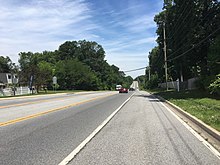Old Baltimore Pike
Old Baltimore Pike is a road in the U.S. state of Delaware. The road, known as New Castle County Road 26, runs from Maryland Route 281 (MD 281) at the Maryland state line south of Newark, Delaware and continues east to Christiana, ending near Delaware Route 1 (DE 1). The road is paralleled by Interstate 95 (I-95, Delaware Turnpike) to the north and U.S. Route 40 (US 40, Pulaski Highway) to the south. The Old Baltimore Pike was built before 1720 and connected Elkton, Maryland to Christiana. It was a turnpike called the Elk and Christiana Turnpike between 1817 and 1838. In the past it served as a major connection between Philadelphia and Baltimore.
| Old Baltimore Pike | |
|---|---|
 | |
| Route information | |
| Maintained by DelDOT | |
| Length | 8.35 mi[1] (13.44 km) |
| Tourist routes | Washington–Rochambeau Revolutionary Route |
| Major junctions | |
| West end | |
| East end | Dead end near Christiana |
| Location | |
| Counties | New Castle |
| Highway system | |
| |
Route description

Old Baltimore Pike begins at the Delaware–Maryland state line near the city of Newark, Delaware, where the highway continues west into that state as MD 281. The road heads northeast from the state line through wooded residential areas as a two-lane undivided road, intersecting Otts Chapel Road/Pleasant Valley Road before crossing Muddy Run and passing south of Iron Hill Park. Old Baltimore Pike crosses DE 896 and enters rural areas. Here, the roadway heads across the Christina River and passes Cooch's Bridge, a historic battle site of the American Revolutionary War. It then crosses Norfolk Southern's Delmarva Secondary railroad line at-grade and meets DE 72 at a junction.[2][3]
After this intersection, Old Baltimore Pike continues past suburban neighborhoods, gaining a center left-turn lane and intersecting Salem Church Road. Farther east, the highway reaches a junction with DE 273 in a wooded area. At this point, the road narrows to two lanes again and heads into the community of Christiana. Here, the highway intersects DE 7, where it turns north and follows that route through residential areas. DE 7 turns east to reach an interchange with DE 1 to the west of the Christiana Mall, where DE 7 continues north along with DE 1 and Old Baltimore Pike reaches a dead end.[2][3]
The entire length of Old Baltimore Pike is part of the Washington–Rochambeau Revolutionary Route, a National Historic Trail.[4] Old Baltimore Pike has an annual average daily traffic count ranging from a high of 21,327 vehicles at the Walther Road intersection to a low of 770 vehicles at the eastern terminus.[1] None of Old Baltimore Pike is part of the National Highway System.[5]
History
The Old Baltimore Pike was built before 1720. The road was known as the Great Road and ran between Head of Elk (now Elkton, Maryland) and Christiana Bridge. It was later known as the Christiana-Elkton Turnpike before becoming Old Baltimore Pike. This path served as a major connection between Philadelphia and Baltimore in addition to providing access between the shipping area of Christiana Bridge and agricultural areas in northern Delaware, northern Maryland, and southeastern Pennsylvania.[6] In 1723, Welsh Tract settlers pushed for the road to be improved.[7] This road was part of the Washington–Rochambeau Revolutionary Route that was used by the French army during their march from Newport, Rhode Island to Yorktown during the Revolutionary War, passing through the area in September 1781.[8]
The road, also known as Old Post Road, was incorporated in 1813 as the Elk and Christiana Turnpike in order to get more money for repairs. The turnpike was completed in April 1817. As a turnpike, tolls were collected to pay for the maintenance of the road. The construction of the New Castle and Frenchtown Railroad lowered the revenues of the turnpike and it became a public road again in 1838.[7] The road historically went through agricultural areas; however, the surroundings have become more developed over the years.[6] Much of the Old Baltimore Pike remains two lanes.[7]
Major intersections
The entire route is in New Castle County.
| Location | mi[1] | km | Destinations | Notes | |
|---|---|---|---|---|---|
| Newark | 0.00 | 0.00 | Maryland state line; western terminus | ||
| Glasgow | 2.49 | 4.01 | |||
| 3.32 | 5.34 | ||||
| Christiana | 7.10 | 11.43 | |||
| 7.41 | 11.93 | West end of DE 7 overlap | |||
| 8.07 | 12.99 | DE 1 exit 164; east end of DE 7 overlap | |||
| 8.35 | 13.44 | Dead end | Eastern terminus | ||
1.000 mi = 1.609 km; 1.000 km = 0.621 mi
| |||||
See also

References
- Staff (2018). "Traffic Count and Mileage Report: New Castle County" (PDF). Delaware Department of Transportation. Retrieved March 29, 2020.
- Delaware Department of Transportation (2017). Official Travel & Transportation Map (PDF) (Map). Dover: Delaware Department of Transportation. Retrieved August 18, 2019.
- Google (July 9, 2010). "Old Baltimore Pike" (Map). Google Maps. Google. Retrieved July 9, 2010.
- "Washington-Rochambeau Revolutionary Route". Delaware Department of Transportation. Retrieved April 7, 2018.
- National Highway System: Delaware (PDF) (Map). Federal Highway Administration. 2010. Retrieved February 10, 2012.
- "Public Information Handout - Cultural Resources Project Old Baltimore Pike from DE Route 273 (Christiana By-Pass) to DE Route 896 (Four Seasons Parkway)" (PDF). Delaware Department of Transportation. Retrieved November 17, 2011.
- "Old Baltimore Pike". Pencader Heritage Area Association. Retrieved November 17, 2011.
- "Home". The National Washington-Rochambeau Revolutionary Route Association, Inc. Retrieved April 7, 2018.
External links
